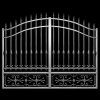Although in in the examples given, the high contrast and the nearly monochrome background was almost certainly obtained by good lighting and very careful selection of the location, framing the shot, choice of time of day and weather, etc., for ordinary mortals who don't have the time and/or access to the necessary lighting equipment, one can use post processing techniques to approximate that look even if you have to start with a more casually snapped photo.
For example, I started with this photo ...

and then performed the following steps:
a) made masks to select the model, and a separate mask to select just the model's head;
b) saved the model's head to its own layer at the top of the stack;
c) fully desaturated the background;
d) used the "bleach bypass" technique on the clothing to bring more visual attention to it;
e) adjusted the brightness and contrast of the background to taste.
f) For yucks, changed the model's jacket from the dull olive drab color to a brown, a bit closer to the garments in some of the examples provided.
BTW, to speed up the production of this demo, instead of using Photoshop's native tools to do a "bleach bypass" effect (many on-line tutorials available), I used the similarly named tool from NIK Color Efx Pro's set.
The result was:

This certainly is not identical to the look in examples provided by the OP, but at least it's sorta-kinda moving the image in the right direction.
HTH,
Tom
PS - Pls. ignore the lousy masking job around the model's hair. I didn't feel like spending time to refine it as this is a demo of colors and tonalities, not masking.






